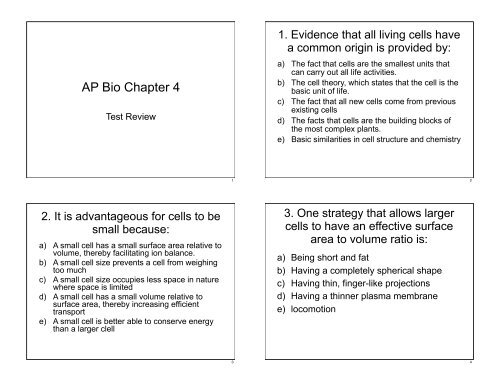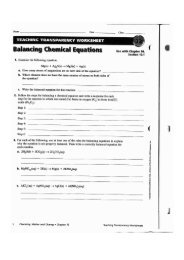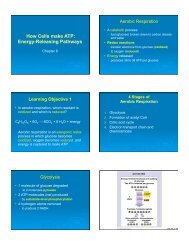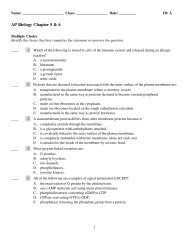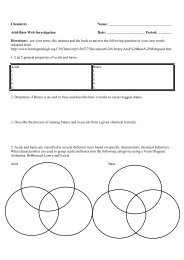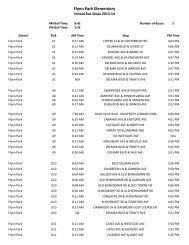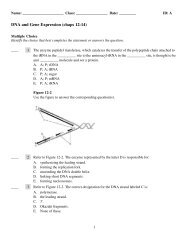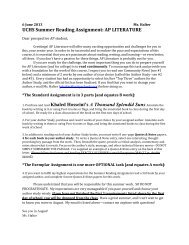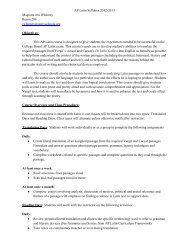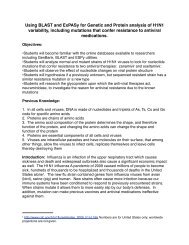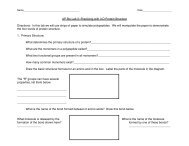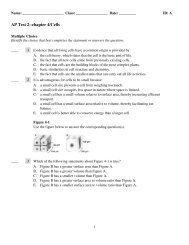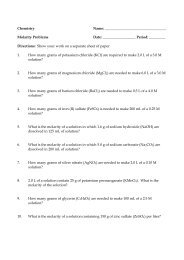AP Bio Chapter 4 - University City Schools
AP Bio Chapter 4 - University City Schools
AP Bio Chapter 4 - University City Schools
Create successful ePaper yourself
Turn your PDF publications into a flip-book with our unique Google optimized e-Paper software.
<strong>AP</strong> <strong>Bio</strong> <strong>Chapter</strong> 4Test Review1. Evidence that all living cells havea common origin is provided by:a) The fact that cells are the smallest units thatcan carry out all life activities.b) The cell theory, which states that the cell is thebasic unit of life.c) The fact that all new cells come from previousexisting cellsd) The facts that cells are the building blocks ofthe most complex plants.e) Basic similarities in cell structure and chemistry122. It is advantageous for cells to besmall because:a) A small cell has a small surface area relative tovolume, thereby facilitating ion balance.b) A small cell size prevents a cell from weighingtoo muchc) A small cell size occupies less space in naturewhere space is limitedd) A small cell has a small volume relative tosurface area, thereby increasing efficienttransporte) A small cell is better able to conserve energythan a larger clell3. One strategy that allows largercells to have an effective surfacearea to volume ratio is:a) Being short and fatb) Having a completely spherical shapec) Having thin, finger-like projectionsd) Having a thinner plasma membranee) locomotion34
4. The ratio of the size of the imageseen with the microscope to theactual size of the object is called:a) Resolutionb) Resolving powerc) Centrifugationd) Fractionatione) magnification5. Differential centrifugation is aprocess that:a) Separates different components of the cell thatfunction differentlyb) Separates components of the cell that have adifferent chemical makeupc) Analyzes the chemical components of the celld) Separates components of the cell that havedifferent densitiese) Allows researchers to view the contents of thecells566. A eukaryotic cell:a) Is usually smaller than a prokaryotic cellb) Typically has a cell wall in addition to aplasma membranec) Is exemplified by bacteriad) Has a variety of membranous organellese) Has its DNA concentrated in one area ofthe cell without a nuclear membrane7. Membrane-bounded organellesfacilitate faster chemical reactionsbecause:a) Reactants are within closer proximity to eachotherb) Membranes lower the activation energy ofbiochemical reactionsc) Reactants move faster within membraneboundedorganellesd) Reactants are less likely to encounter eachother within membrane-bounded organellese) Membrane-bounded organelles act as catalystsfor biochemical reactions78
8. Which of the following structuresor activities is NOT directly part ofthe endomembrane system?a) Buddingb) Lysosomesc) Ribosomesd) Gogli complexe) peroxisomes9. DNA is associated with proteins,forming a complex called:a) Nucleusb) Genesc) Chromatind) Chromosomese) nucleoli91010. In the classic experiments by Bracht andHammerling, the nucleus of Acetabularia wasremoved, the cap was cut off, a nucleus of a differentspecies was inserted, and the cap was allowed toregenerate. The new cap was then removed. After thesecond regeneration, the cap was observed, and thefollowing conclusion was made:a) The shape of the cap was controlled by the nucleus, thus,the nucleus was the control center of the cellb) The shape of the cap was under control of the stalk, whichproduced a control substancec) At the time no conclusion could be made because in theearly 20 th century, biologists did not know about thecompostion of DNAd) The shape of the cap was independent of both the stalk andholdfaste) The “cren” caps were defective due to some mutation in thecap. Thus, “cren” caps are independent of the control fromboth the base and the holdfast.1111. If a toxin, such as bacterialtoxin, destroys ribosomes, whatcellular activity will be affected first?a) Energy storageb) Active transportc) Protein synthesisd) DNA synthesise) movement12
12. The smooth endoplasmicreticulum:a) Synthesis lipidsb) Is absent in most plant cellsc) Synthesis proteinsd) Provides structural supporte) Is required for ribosome synthesis13. Proteins made on ribosomesmay be be further modified withinthe:a) Nucleusb) Lysosomesc) Mitochondriad) Golgi complexe) peroxisomes131414. The ____ can be considered asorting, processing and packagingcenter.a) Centrioleb) Vacuolec) Cytoskeletond) Centrosomee) Golgi complex15. During an infection, white bloodcells travel to the infected site andphagocytic vesile to form a largervesicle called a secondary lysosome.The reason for this is:a) To coat the bacteria in lipids derived from the Golgicomplex, which cover ang smother themb) To introduce antibodies to the phagocytic vesiclesc) To wrap the pathogen in additional membrane,rendering them harmlessd) To mix the pathogens with strong hydrolyticenzymes and destroy theme) To prepare the bacteria for export from the body1516
16. All of the following functions arepreformed by plant vacuolesEXCEPT:a) Maintaing hydrostatic (turgor) pressureb) Breakdown of unneeded cellularmaterialsc) Storage of nucleic acidsd) Waste storage and recyclinge) Storage of proteins17. One function of peroxisomesinvolves the process of:a) Protein synthesisb) Cell deathc) Water storaged) DNA replicatione) detoxifation171818. The theory that chloroplasts andmitochondria had their evolutionarybeginnings in eukaryotic cells asendosymbionts is supported by all ofthe following EXCEPT:a) Chloroplasts and mitochondria are approximatelythe same size as prokaryotic cellsb) Chloroplasts and mitochondria have the sameshape as prokaryotic cellsc) Chloroplasts and mitochondria are completelyautonomous within eukaryotic cellsd) Chloroplasts and mitochondria have DNAe) Chloroplasts and mitochondria have smallribosomes for protein synthesis19. Which of the following organellesplays an important role in apoptosis,or programmed cell death?a) Ribosomesb) Vacuolesc) Mitochondriad) Chloroplastse) Peroxisomes1920
20. A cellular structure found inplant but not in animal cells is the:a) Endoplasmic reticulumb) Microtubulec) Chloroplastd) Ribosomee) Microfilament21. Which of the following is a keycomponent of the cytoskeleton?a) Centrosomeb) Microtubesc) DNAd) Ribosomese) Endoplasmic reticulum212222. The force necessary to causemicrotubules of cilia and flagella toslide alongside one another isprovided through the action of ____proteins, which derive the energy toperform their work directly from_____ moleculesa) Dynein, ATPb) Dynein, ADPc) Kinesin, ADPd) Kinesin, glucosee) Tubulin, ATP 2323. Which of the following pairs iscorrectly matched?a) Primary cell wall- pectinb) Middle lamella- cellulosec) Integrins- receptorsd) Fibronectins-woode) Secondary cell wall- glycoproteins24
24. Which of the following is NOT acell covering or part of a cellcovering?a) Cristaeb) Cell wallc) Glycocalyxd) Extracellular matrixe) integrins25


